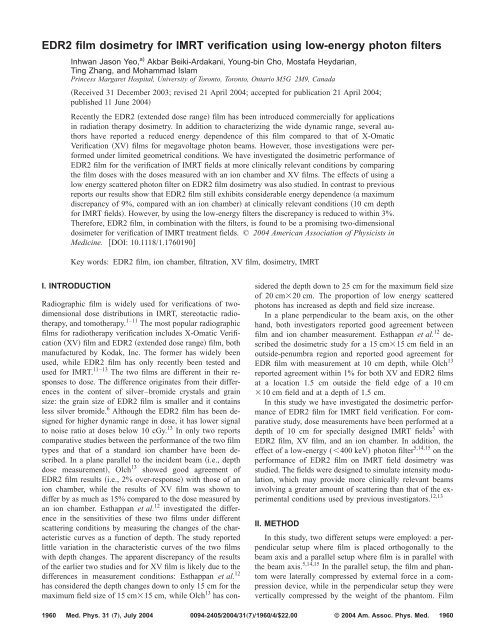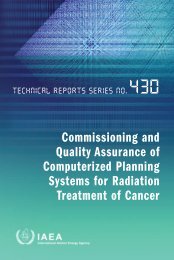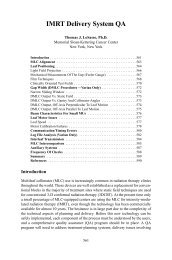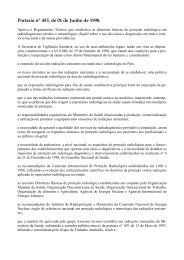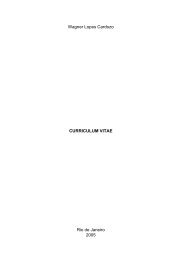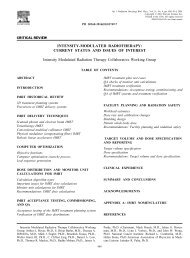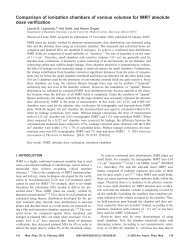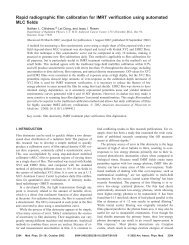EDR2 film dosimetry for IMRT verification using low-energy photon ...
EDR2 film dosimetry for IMRT verification using low-energy photon ...
EDR2 film dosimetry for IMRT verification using low-energy photon ...
You also want an ePaper? Increase the reach of your titles
YUMPU automatically turns print PDFs into web optimized ePapers that Google loves.
<strong>EDR2</strong> <strong>film</strong> <strong>dosimetry</strong> <strong>for</strong> <strong>IMRT</strong> <strong>verification</strong> <strong>using</strong> <strong>low</strong>-<strong>energy</strong> <strong>photon</strong> filters<br />
Inhwan Jason Yeo, a) Akbar Beiki-Ardakani, Young-bin Cho, Mostafa Heydarian,<br />
Ting Zhang, and Mohammad Islam<br />
Princess Margaret Hospital, University of Toronto, Toronto, Ontario M5G 2M9, Canada<br />
Received 31 December 2003; revised 21 April 2004; accepted <strong>for</strong> publication 21 April 2004;<br />
published 11 June 2004<br />
Recently the <strong>EDR2</strong> extended dose range <strong>film</strong> has been introduced commercially <strong>for</strong> applications<br />
in radiation therapy <strong>dosimetry</strong>. In addition to characterizing the wide dynamic range, several authors<br />
have reported a reduced <strong>energy</strong> dependence of this <strong>film</strong> compared to that of X-Omatic<br />
Verification XV <strong>film</strong>s <strong>for</strong> megavoltage <strong>photon</strong> beams. However, those investigations were per<strong>for</strong>med<br />
under limited geometrical conditions. We have investigated the dosimetric per<strong>for</strong>mance of<br />
<strong>EDR2</strong> <strong>film</strong> <strong>for</strong> the <strong>verification</strong> of <strong>IMRT</strong> fields at more clinically relevant conditions by comparing<br />
the <strong>film</strong> doses with the doses measured with an ion chamber and XV <strong>film</strong>s. The effects of <strong>using</strong> a<br />
<strong>low</strong> <strong>energy</strong> scattered <strong>photon</strong> filter on <strong>EDR2</strong> <strong>film</strong> <strong>dosimetry</strong> was also studied. In contrast to previous<br />
reports our results show that <strong>EDR2</strong> <strong>film</strong> still exhibits considerable <strong>energy</strong> dependence a maximum<br />
discrepancy of 9%, compared with an ion chamber at clinically relevant conditions 10 cm depth<br />
<strong>for</strong> <strong>IMRT</strong> fields. However, by <strong>using</strong> the <strong>low</strong>-<strong>energy</strong> filters the discrepancy is reduced to within 3%.<br />
There<strong>for</strong>e, <strong>EDR2</strong> <strong>film</strong>, in combination with the filters, is found to be a promising two-dimensional<br />
dosimeter <strong>for</strong> <strong>verification</strong> of <strong>IMRT</strong> treatment fields. © 2004 American Association of Physicists in<br />
Medicine. DOI: 10.1118/1.1760190<br />
Key words: <strong>EDR2</strong> <strong>film</strong>, ion chamber, filtration, XV <strong>film</strong>, <strong>dosimetry</strong>, <strong>IMRT</strong><br />
I. INTRODUCTION<br />
Radiographic <strong>film</strong> is widely used <strong>for</strong> <strong>verification</strong>s of twodimensional<br />
dose distributions in <strong>IMRT</strong>, stereotactic radiotherapy,<br />
and tomotherapy. 1–11 The most popular radiographic<br />
<strong>film</strong>s <strong>for</strong> radiotherapy <strong>verification</strong> includes X-Omatic Verification<br />
XV <strong>film</strong> and <strong>EDR2</strong> extended dose range <strong>film</strong>, both<br />
manufactured by Kodak, Inc. The <strong>for</strong>mer has widely been<br />
used, while <strong>EDR2</strong> <strong>film</strong> has only recently been tested and<br />
used <strong>for</strong> <strong>IMRT</strong>. 11–13 The two <strong>film</strong>s are different in their responses<br />
to dose. The difference originates from their differences<br />
in the content of silver–bromide crystals and grain<br />
size: the grain size of <strong>EDR2</strong> <strong>film</strong> is smaller and it contains<br />
less silver bromide. 6 Although the <strong>EDR2</strong> <strong>film</strong> has been designed<br />
<strong>for</strong> higher dynamic range in dose, it has <strong>low</strong>er signal<br />
to noise ratio at doses be<strong>low</strong> 10 cGy. 13 In only two reports<br />
comparative studies between the per<strong>for</strong>mance of the two <strong>film</strong><br />
types and that of a standard ion chamber have been described.<br />
In a plane parallel to the incident beam i.e., depth<br />
dose measurement, Olch 13 showed good agreement of<br />
<strong>EDR2</strong> <strong>film</strong> results i.e., 2% over-response with those of an<br />
ion chamber, while the results of XV <strong>film</strong> was shown to<br />
differ by as much as 15% compared to the dose measured by<br />
an ion chamber. Esthappan et al. 12 investigated the difference<br />
in the sensitivities of these two <strong>film</strong>s under different<br />
scattering conditions by measuring the changes of the characteristic<br />
curves as a function of depth. The study reported<br />
little variation in the characteristic curves of the two <strong>film</strong>s<br />
with depth changes. The apparent discrepancy of the results<br />
of the earlier two studies and <strong>for</strong> XV <strong>film</strong> is likely due to the<br />
differences in measurement conditions: Esthappan et al. 12<br />
has considered the depth changes down to only 15 cm <strong>for</strong> the<br />
maximum field size of 15 cm15 cm, while Olch 13 has considered<br />
the depth down to 25 cm <strong>for</strong> the maximum field size<br />
of 20 cm20 cm. The proportion of <strong>low</strong> <strong>energy</strong> scattered<br />
<strong>photon</strong>s has increased as depth and field size increase.<br />
In a plane perpendicular to the beam axis, on the other<br />
hand, both investigators reported good agreement between<br />
<strong>film</strong> and ion chamber measurement. Esthappan et al. 12 described<br />
the dosimetric study <strong>for</strong> a 15 cm15 cm field in an<br />
outside-penumbra region and reported good agreement <strong>for</strong><br />
EDR <strong>film</strong> with measurement at 10 cm depth, while Olch 13<br />
reported agreement within 1% <strong>for</strong> both XV and <strong>EDR2</strong> <strong>film</strong>s<br />
at a location 1.5 cm outside the field edge of a 10 cm<br />
10 cm field and at a depth of 1.5 cm.<br />
In this study we have investigated the dosimetric per<strong>for</strong>mance<br />
of <strong>EDR2</strong> <strong>film</strong> <strong>for</strong> <strong>IMRT</strong> field <strong>verification</strong>. For comparative<br />
study, dose measurements have been per<strong>for</strong>med at a<br />
depth of 10 cm <strong>for</strong> specially designed <strong>IMRT</strong> fields 5 with<br />
<strong>EDR2</strong> <strong>film</strong>, XV <strong>film</strong>, and an ion chamber. In addition, the<br />
effect of a <strong>low</strong>-<strong>energy</strong> (400 keV) <strong>photon</strong> filter 5,14,15 on the<br />
per<strong>for</strong>mance of <strong>EDR2</strong> <strong>film</strong> on <strong>IMRT</strong> field <strong>dosimetry</strong> was<br />
studied. The fields were designed to simulate intensity modulation,<br />
which may provide more clinically relevant beams<br />
involving a greater amount of scattering than that of the experimental<br />
conditions used by previous investigators. 12,13<br />
II. METHOD<br />
In this study, two different setups were employed: a perpendicular<br />
setup where <strong>film</strong> is placed orthogonally to the<br />
beam axis and a parallel setup where <strong>film</strong> is in parallel with<br />
the beam axis. 5,14,15 In the parallel setup, the <strong>film</strong> and phantom<br />
were laterally compressed by external <strong>for</strong>ce in a compression<br />
device, while in the perpendicular setup they were<br />
vertically compressed by the weight of the phantom. Film<br />
1960 Med. Phys. 31 „7…, July 2004 0094-2405Õ2004Õ31„7…Õ1960Õ4Õ$22.00 © 2004 Am. Assoc. Phys. Med. 1960
1961 Yeo et al.: <strong>EDR2</strong> <strong>film</strong> <strong>dosimetry</strong> with filters <strong>for</strong> <strong>IMRT</strong> 1961<br />
TABLE I. Calibration setup used in this study. * an additional <strong>film</strong> <strong>for</strong> background is needed.<br />
Film and beam<br />
alignment<br />
Filter<br />
MUs <strong>for</strong> XV*<br />
MUs <strong>for</strong> <strong>EDR2</strong>*<br />
SSD<br />
cm<br />
Field size<br />
cm<br />
Measurement<br />
condition<br />
Perpendicular<br />
No<br />
5,10,15,20,25,30,35,40,45,50<br />
5,10,20,50,100,150,200,250<br />
100 66 10 cm depth<br />
calibration curves were determined under calibration conditions<br />
which are summarized in Table I. No additional calibration<br />
was per<strong>for</strong>med with the filters in place. This is because<br />
the amount of scattering and thus the effect of filtration<br />
are minimal (2%, a relatively small value compared with<br />
the <strong>film</strong> error at beam axis of the small field size used in this<br />
study. The <strong>film</strong> setup is similar to those employed in our past<br />
studies and 0.15-mm-thick lead filters were placed at 6 mm<br />
distance from the <strong>film</strong> on both sides. 5,14,15<br />
<strong>IMRT</strong> beams which are measurable by an ion chamber<br />
have been designed to test the dosimetric response of the two<br />
<strong>film</strong>s: the two types of <strong>IMRT</strong> beams produce pyramid and<br />
inverse-pyramid density shapes on the <strong>film</strong>. They are similar<br />
to those we have previously employed but the current beams<br />
involve more scattering: A graphical representation of these<br />
beams was previously given. 5 Segment combinations of<br />
these beams are shown in Tables II and III, respectively. The<br />
fields simulates intensity modulation, which provides a<br />
greater amount of scattering than the experimental conditions<br />
used by previous investigators. 12,13 The monitor units and the<br />
minimum field size were carefully chosen to avoid <strong>film</strong> saturation<br />
and to ensure electronic equilibrium. Parallel exposures<br />
with and without the filters in place were per<strong>for</strong>med as<br />
they have been used consistently in the past <strong>for</strong> the evaluation<br />
of <strong>film</strong> response. 5,14,15<br />
The transverse dose profile of each segment in the tables<br />
was measured at 10 cm depth in a water phantom <strong>using</strong> a<br />
0.125 cm 3 ion chamber IC10. Charge collection <strong>for</strong> the<br />
same number of MUs was per<strong>for</strong>med on the central axis at<br />
10 cm depth <strong>for</strong> each segment of the pyramid beam in Table<br />
II. For the segments of the inverse-pyramid beam shown in<br />
Table III, the charge was collected at 8.3 cm off-axis distance<br />
or X1 in the dose plateau region at the depth of 10 cm. The<br />
dose to MU ratio i.e., cGy/MU was first obtained <strong>for</strong> segment<br />
E of the pyramid beam <strong>using</strong> the output factor and the<br />
percentage depth dose <strong>for</strong> the given conditions i.e., field size<br />
and SSD. Dose to MU ratios <strong>for</strong> the other segments were<br />
individually obtained by multiplying the earlier ratio <strong>for</strong> segment<br />
E by the ratio between the collected charges of each<br />
segment and segment E. For each segment, these ratios were<br />
then multiplied by the delivered MUs to generate the absolute<br />
dose value at the measurement point. This value was<br />
used <strong>for</strong> the normalization of the measured relative dose profile<br />
of the corresponding segment in order to determine the<br />
absolute dose profile. By adding together the absolute dose<br />
profiles of all involved segments in the pyramid and inversepyramid<br />
beams, their corresponding composite dose profiles<br />
were created.<br />
Dose calculations were also per<strong>for</strong>med <strong>using</strong> a treatment<br />
planning system TPS Cadplan, Varian, Inc. with the same<br />
beam configurations and compared with the measured results.<br />
This was done because the <strong>film</strong> <strong>dosimetry</strong> is normally<br />
compared with the TPS calculation and thus the evaluation<br />
of the accuracy of the TPS relative to ion-chamber measurement<br />
is necessary.<br />
III. RESULT AND DISCUSSIONS<br />
Figure 1 shows the polynomials of the characteristic<br />
curves of the two <strong>film</strong>s that fit the measured data obtained<br />
<strong>using</strong> the condition described in Table I. The curves were<br />
used to convert the optical densities of the exposed <strong>film</strong>s to<br />
the dose.<br />
Figures 2 and 3 show the profiles of the pyramid and<br />
inverse-pyramid beams, respectively, measured by <strong>EDR2</strong><br />
<strong>film</strong>. Figures 4 and 5 show the corresponding results <strong>for</strong> XV<br />
<strong>film</strong>. In the high dose region of the pyramid field, <strong>EDR2</strong> <strong>film</strong><br />
showed an over-response of a few percent from the standard<br />
ion chamber measurement, while XV <strong>film</strong> showed good<br />
agreement. Moreover, there is a negligible effect of the filtration<br />
<strong>for</strong> the two <strong>film</strong>s in the high dose region. This can be<br />
explained by the fact that the high dose region is on the<br />
central axis under these exposure conditions Table II,<br />
where a minimal amount of scattered <strong>photon</strong>s are present.<br />
On the other hand, in the high dose region of the inversepyramid<br />
field, the two <strong>film</strong>s over-responded by approximately<br />
5%–6%, relative to the dose maximum. The effect of<br />
filtration in this case was significant: it resulted in 4% underresponse<br />
<strong>for</strong> XV <strong>film</strong> and 2% over-response <strong>for</strong> <strong>EDR2</strong> <strong>film</strong>.<br />
The fact that the <strong>film</strong> error is greater <strong>for</strong> the inverse-pyramid<br />
beam than <strong>for</strong> the pyramid beam and the filtration effect was<br />
significant <strong>for</strong> the inverse-pyramid field can be simply explained<br />
by the difference between the two conditions: the<br />
difference is characterized by the fact that the high dose re-<br />
TABLE II. Irradiation conditions <strong>for</strong> the pyramid field. Y<br />
(or in-plane field length)21 cm. Gantry and collimator at 0°. Energy<br />
6 MV. SSD100 cm. 10 MUs was used <strong>for</strong> each field.<br />
Field size A B C D E<br />
X1/X2 3/3 4.5/4.5 6/6 7.5/7.5 9/9<br />
TABLE III. Irradiation conditions <strong>for</strong> the inverse-pyramid field. Y<br />
(or in-plane field length)21 cm. Gantry and collimator at 0°. Energy<br />
6 MV. SSD100 cm. 7 MUs were used <strong>for</strong> each field.<br />
Field<br />
size A B C D E F G<br />
X1/X210.5/4.5 10.5/3.0 10.5/1.5 10.5/10.51.5/10.53/10.54.5/10.5<br />
Medical Physics, Vol. 31, No. 7, July 2004
1962 Yeo et al.: <strong>EDR2</strong> <strong>film</strong> <strong>dosimetry</strong> with filters <strong>for</strong> <strong>IMRT</strong> 1962<br />
FIG. 1. Characteristic curves <strong>for</strong> XV and EDR 2 <strong>film</strong>s.<br />
FIG. 4. The pyramid beam profiles measured by XV <strong>film</strong> at the depth of 10<br />
cm.<br />
FIG. 2. The pyramid beam profiles measured by <strong>EDR2</strong> <strong>film</strong> at the depth of<br />
10 cm.<br />
gion of the inverse-pyramid field is affected by the outside<br />
penumbral irradiation of segments, while that of the pyramid<br />
field is not.<br />
In the outside penumbra region of the pyramid and<br />
inverse-pyramid fields and the central part local minimum<br />
of the inverse-pyramid field where the <strong>low</strong>-<strong>energy</strong> <strong>photon</strong>s<br />
are abundant, the over-response of the two <strong>film</strong>s is about 9%<br />
of the maximum dose. This corresponds to a significant overresponse<br />
of as much as 100% relative to the local dose in the<br />
above areas. Significant reduction down to 3% was<br />
achieved by <strong>using</strong> the filers of the <strong>low</strong>-<strong>energy</strong> <strong>photon</strong>s. This<br />
reduction which was previously shown <strong>for</strong> relative <strong>dosimetry</strong><br />
<strong>using</strong> XV <strong>film</strong> 5 has been reproduced in this study <strong>for</strong> absolute<br />
<strong>dosimetry</strong> <strong>using</strong> the two <strong>film</strong>s. However, the observed<br />
over-response of <strong>EDR2</strong> <strong>film</strong> is different from or may<br />
complement the finding of the previous studies 12,13 discussed<br />
in the introduction. The reason is in the differences<br />
between the measurement condition employed in this study<br />
and that in the previous studies. Measurement of the dose<br />
profiles in this study was at 10 cm depth, which is much<br />
FIG. 3. The inverse-pyramid beam profiles measured by <strong>EDR2</strong> <strong>film</strong> at the<br />
depth of 10 cm.<br />
FIG. 5. The inverse-pyramid beam profiles measured by XV <strong>film</strong> at the<br />
depth of 10 cm.<br />
Medical Physics, Vol. 31, No. 7, July 2004
1963 Yeo et al.: <strong>EDR2</strong> <strong>film</strong> <strong>dosimetry</strong> with filters <strong>for</strong> <strong>IMRT</strong> 1963<br />
greater and clinically more relevant than that used by Olch. 13<br />
In addition, the field size we used is greater than that employed<br />
by Esthappan. 12 Additionally with several steps of<br />
intensity modulation, the radiation conditions in this study<br />
are associated with more scattered <strong>photon</strong>s (400 keV). As<br />
a result, <strong>EDR2</strong> <strong>film</strong> tends to respond less accurately within<br />
the <strong>IMRT</strong> field area due to the presence of high density silver<br />
bromide.<br />
Whereas <strong>EDR2</strong> <strong>film</strong> was reported to be an accurate dosimeter<br />
<strong>for</strong> depth dose measurement by the past two<br />
studies, 12,13 it is shown to be not as accurate <strong>for</strong> <strong>IMRT</strong> profile<br />
measurement by this study. This makes it interesting to note<br />
the different finding on <strong>EDR2</strong> <strong>film</strong> between the two planes of<br />
measurement parallel and perpendicular to the beam. The<br />
difference between the two planes is attributed to the difference<br />
in the radiation conditions of the two planes characterized<br />
by the proportion of the <strong>low</strong>-<strong>energy</strong> <strong>photon</strong>s. In the<br />
parallel plane, the amount of the <strong>low</strong>-<strong>energy</strong> <strong>photon</strong>s increases<br />
as depth increases, but their proportion in an entire<br />
spectrum is still influenced by the higher <strong>energy</strong> part of the<br />
spectrum. On the contrary, in the perpendicular plane at<br />
some sufficient depth beyond the depth of the dose maximum<br />
the <strong>low</strong>-<strong>energy</strong> <strong>photon</strong>s are mainly present outside the<br />
penumbra region, and their effect are dominant there. There<strong>for</strong>e,<br />
the contribution of the <strong>low</strong>-<strong>energy</strong> <strong>photon</strong>s to the <strong>film</strong><br />
response is more pronounced in the profile measurement<br />
outside penumbra at deep parts of a phantom. This appears<br />
to be the most reasonable explanation that hardly makes the<br />
change made in the silver–bromide content of <strong>EDR2</strong> <strong>film</strong><br />
effective in enhancing the dosimetric properties of the <strong>film</strong><br />
i.e., less sensitive to the <strong>low</strong>-<strong>energy</strong> <strong>photon</strong>s <strong>for</strong> profile<br />
measurement.<br />
The TPS calculations agree well with ion chamber measurement<br />
in the high dose region. However, they show an<br />
under-response of around 3%, compared with the ion chamber<br />
measurement, in the outside-penumbra regions and the<br />
local minimum of the inverse-pyramid field, while it shows<br />
agreement in the outside penumbra regions of the pyramid<br />
field. This discrepancy is due to the fact that the points in the<br />
areas of the outside-penumbra and the local minimum of the<br />
inverse-pyramid field is closer to the edges of the beamlets<br />
than that of the pyramid field is. There<strong>for</strong>e, the known underresponse<br />
of the dose calculation of the TPS in outside penumbra<br />
regions 16 has contributed to the response to the<br />
inverse-pyramid field.<br />
IV. CONCLUSION<br />
While <strong>for</strong> the measurement in a parallel plane to the beam<br />
axis <strong>EDR2</strong> <strong>film</strong> is reported to be more accurate than XV <strong>film</strong>,<br />
the <strong>for</strong>mer is comparable to the latter <strong>for</strong> the measurement in<br />
a perpendicular plane <strong>for</strong> <strong>IMRT</strong> beams which involve great<br />
amount of <strong>low</strong>-<strong>energy</strong> scattered <strong>photon</strong>s. Similarly to XV<br />
<strong>film</strong>, the use of filters significantly reduces errors in <strong>EDR2</strong><br />
<strong>film</strong> <strong>dosimetry</strong> and results in an agreement with the ion<br />
chamber to within 3%. This is a promising result considering<br />
the limited accuracy of treatment planning calculations<br />
to which <strong>film</strong> measurement is compared clinically and the<br />
current difficulty to measure the dose distribution from an<br />
<strong>IMRT</strong> beam with both accuracy and fine resolution. The use<br />
of the filters <strong>for</strong> the profile measurement, together with the<br />
proven accuracy <strong>for</strong> depth dose measurement, 13 enables accurate<br />
<strong>dosimetry</strong> <strong>using</strong> <strong>EDR2</strong> <strong>film</strong> in nearly any measurement<br />
point throughout a phantom. Film <strong>dosimetry</strong> can be<br />
quantitatively per<strong>for</strong>med based on the evaluated errors of<br />
both <strong>film</strong> <strong>dosimetry</strong> and TPS calculation.<br />
a Author to whom correspondence should be addressed; electronic mail:<br />
medicphys@hotmail.com<br />
1 B. Paliwal, W. Tomé, S. Richardson, and T. R. Mackie, ‘‘A spiral phantom<br />
<strong>for</strong> <strong>IMRT</strong> and tomotherapy treatment delivery <strong>verification</strong>,’’ Med.<br />
Phys. 27, 2503 2000.<br />
2 M. Oldham and S. Webb, ‘‘Intensity-modulated radiotherapy by means of<br />
static tomotherapy: A planning and <strong>verification</strong> study,’’ Med. Phys. 24,<br />
827–836 1997.<br />
3 J. N. Yang, T. R. Mackie, P. Reckwerdt, J. O. Deasy, and B. R. Thomadsen,<br />
‘‘An investigation of tomotherapy beam delivery,’’ Med. Phys. 24,<br />
425–436 1997.<br />
4 T. D. Solberg, F. E. Holly, De Salles, A. F. Antonio, R. E. Wallace, and J.<br />
B. Smathers, ‘‘Implications of tissue heterogeneity <strong>for</strong> radiosurgery in<br />
head and neck tumors,’’ Int. J. Radiat. Oncol., Biol., Phys. 32, 235–239<br />
1995.<br />
5 S. G. Ju, Y. C. Ahn, S. J. Huh, and I. J. Yeo, ‘‘Film <strong>dosimetry</strong> <strong>for</strong> intensity<br />
modulated radiation therapy,’’ Med. Phys. 29, 351–355 2002.<br />
6 I. J. Yeo, C. Wang, and S. E. Burch, ‘‘A new approach to <strong>film</strong> <strong>dosimetry</strong><br />
<strong>for</strong> high-<strong>energy</strong> <strong>photon</strong> beam <strong>using</strong> organic plastic scintillators,’’ Phys.<br />
Med. Biol. 44, 3055–3069 1999.<br />
7 J. F. Williamson, ‘‘Film <strong>dosimetry</strong> of megavoltage <strong>photon</strong> beams: A practical<br />
method of isodensity-to-isodose curve conversion,’’ Med. Phys. 8,<br />
84–98 1981.<br />
8 J. Purdy, ‘‘Instrumentation <strong>for</strong> dosimetric measurements,’’ Proceedings of<br />
the AAPM Conference on Electron Linear Accelerators in Radiation<br />
Therapy, 1978.<br />
9 D. A. Low, C. Chao, S. Mutic, R. L. Gerber, C. A. Perez, and J. A. Purdy,<br />
‘‘Quality assurance of serial tomotherapy <strong>for</strong> head and neck patient treatments,’’<br />
Int. J. Radiat. Oncol., Biol., Phys. 42, 681–692 1998.<br />
10 D. A. Low, S. Mutic, J. F. Dempsey, R. L. Gerber, W. R. Bosch, C. A.<br />
Perez, and J. A. Purdy, ‘‘Quantitative dosimetric <strong>verification</strong> of an <strong>IMRT</strong><br />
planning and delivery system,’’ Radiother. Oncol. 49, 305–316 1998.<br />
11 X. R. Zhu, P. A. Jursinic, D. F. Grimm, F. Lopez, J. J. Rownd, and M. T.<br />
Gillin, ‘‘Evaluation of Kodak <strong>EDR2</strong> <strong>film</strong> <strong>for</strong> dose <strong>verification</strong> of intensity<br />
modulated radiation therapy delivered by a static multileaf collimator,’’<br />
Med. Phys. 22, 1687–1692 2002.<br />
12 J. Esthappan, S. Mutic, W. B. Harms, J. F. Dempsey, and D. A. Low,<br />
‘‘Dosimetry of therapeutic <strong>photon</strong> beams <strong>using</strong> an extended dose range<br />
<strong>film</strong>,’’ Med. Phys. 29, 2438–2445 2002.<br />
13 A. J. Olch, ‘‘Dosimetric per<strong>for</strong>mance of an enhanced dose range radiographic<br />
<strong>film</strong> <strong>for</strong> intensity-modulate radiation therapy quality assurance,’’<br />
Med. Phys. 29, 2159–2168 2002.<br />
14 S. E. Burch, K. J. Kearfott, J. H. Trueblood, W. C. Shiels, I. J. Yeo, and<br />
C. K. Wang, ‘‘A new approach to <strong>film</strong> <strong>dosimetry</strong> <strong>for</strong> high <strong>energy</strong> <strong>photon</strong><br />
beam: Lateral scatter filtering,’’ Med. Phys. 24, 775–783 1997.<br />
15 I. J. Yeo, S. E. Burch, and C. K. Wang, ‘‘A filtration method <strong>for</strong> improving<br />
x-ray <strong>film</strong> <strong>dosimetry</strong> in <strong>photon</strong> radiotherapy,’’ Med. Phys. 24, 1943–<br />
1953 1997.<br />
16 P. R. M. Storchi, L. J. van Battum, and E. Woudstra, ‘‘Calculation of a<br />
pencil beam kernel from measured <strong>photon</strong> beam data,’’ Phys. Med. Biol.<br />
44, 2917–2928 1999.<br />
Medical Physics, Vol. 31, No. 7, July 2004


